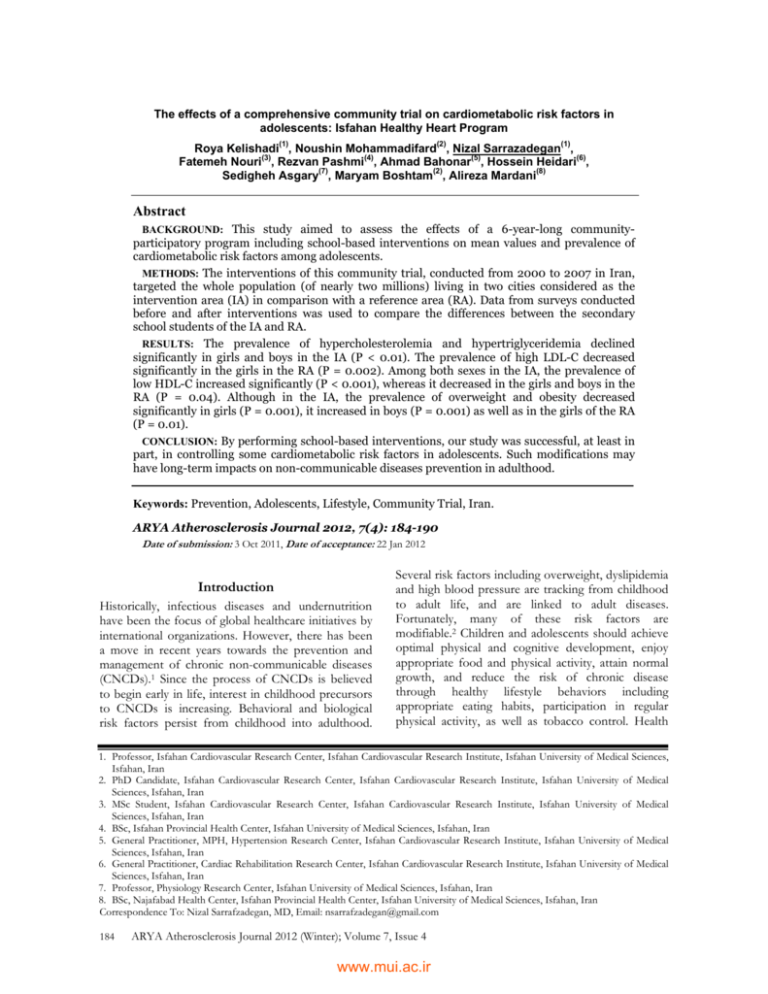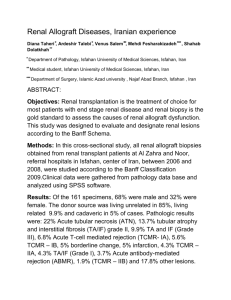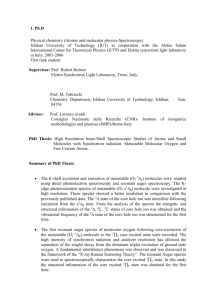www.mui.ac.ir
advertisement

The effects of a comprehensive community trial on cardiometabolic risk factors in adolescents: Isfahan Healthy Heart Program (1) (2) (1) Roya Kelishadi , Noushin Mohammadifard , Nizal Sarrazadegan , Fatemeh Nouri(3), Rezvan Pashmi(4), Ahmad Bahonar(5), Hossein Heidari(6), Sedigheh Asgary(7), Maryam Boshtam(2), Alireza Mardani(8) Abstract BACKGROUND: This study aimed to assess the effects of a 6-year-long communityparticipatory program including school-based interventions on mean values and prevalence of cardiometabolic risk factors among adolescents. METHODS: The interventions of this community trial, conducted from 2000 to 2007 in Iran, targeted the whole population (of nearly two millions) living in two cities considered as the intervention area (IA) in comparison with a reference area (RA). Data from surveys conducted before and after interventions was used to compare the differences between the secondary school students of the IA and RA. RESULTS: The prevalence of hypercholesterolemia and hypertriglyceridemia declined significantly in girls and boys in the IA (P < 0.01). The prevalence of high LDL-C decreased significantly in the girls in the RA (P = 0.002). Among both sexes in the IA, the prevalence of low HDL-C increased significantly (P < 0.001), whereas it decreased in the girls and boys in the RA (P = 0.04). Although in the IA, the prevalence of overweight and obesity decreased significantly in girls (P = 0.001), it increased in boys (P = 0.001) as well as in the girls of the RA (P = 0.01). CONCLUSION: By performing school-based interventions, our study was successful, at least in part, in controlling some cardiometabolic risk factors in adolescents. Such modifications may have long-term impacts on non-communicable diseases prevention in adulthood. Keywords: Prevention, Adolescents, Lifestyle, Community Trial, Iran. ARYA Atherosclerosis Journal 2012, 7(4): 184-190 Date of submission: 3 Oct 2011, Date of acceptance: 22 Jan 2012 Introduction Historically, infectious diseases and undernutrition have been the focus of global healthcare initiatives by international organizations. However, there has been a move in recent years towards the prevention and management of chronic non-communicable diseases (CNCDs).1 Since the process of CNCDs is believed to begin early in life, interest in childhood precursors to CNCDs is increasing. Behavioral and biological risk factors persist from childhood into adulthood. Several risk factors including overweight, dyslipidemia and high blood pressure are tracking from childhood to adult life, and are linked to adult diseases. Fortunately, many of these risk factors are modifiable.2 Children and adolescents should achieve optimal physical and cognitive development, enjoy appropriate food and physical activity, attain normal growth, and reduce the risk of chronic disease through healthy lifestyle behaviors including appropriate eating habits, participation in regular physical activity, as well as tobacco control. Health 1. Professor, Isfahan Cardiovascular Research Center, Isfahan Cardiovascular Research Institute, Isfahan University of Medical Sciences, Isfahan, Iran 2. PhD Candidate, Isfahan Cardiovascular Research Center, Isfahan Cardiovascular Research Institute, Isfahan University of Medical Sciences, Isfahan, Iran 3. MSc Student, Isfahan Cardiovascular Research Center, Isfahan Cardiovascular Research Institute, Isfahan University of Medical Sciences, Isfahan, Iran 4. BSc, Isfahan Provincial Health Center, Isfahan University of Medical Sciences, Isfahan, Iran 5. General Practitioner, MPH, Hypertension Research Center, Isfahan Cardiovascular Research Institute, Isfahan University of Medical Sciences, Isfahan, Iran 6. General Practitioner, Cardiac Rehabilitation Research Center, Isfahan Cardiovascular Research Institute, Isfahan University of Medical Sciences, Isfahan, Iran 7. Professor, Physiology Research Center, Isfahan University of Medical Sciences, Isfahan, Iran 8. BSc, Najafabad Health Center, Isfahan Provincial Health Center, Isfahan University of Medical Sciences, Isfahan, Iran Correspondence To: Nizal Sarrafzadegan, MD, Email: nsarrafzadegan@gmail.com 184 ARYA Atherosclerosis Journal 2012 (Winter); Volume 7, Issue 4 www.mui.ac.ir R Kelishadi, N Mohammadifard, N Sarrazadegan, F Nouri, R Pashmi, A Bahonar, H Heidari, S Asgary, M Boshtam, A Mardani promotion will help reduce lifestyle-related risks of CNCDS. Lifestyle behaviors, which contribute to the leading causes of morbidity and mortality among adults, are often established during childhood and adolescence and extend into adulthood. They are mostly interrelated and preventable. Moreover, cardiometabolic risk factors origin in early life, commonly persist in later life and are mostly strong predictors of chronic diseases in adulthood.3,4 Schools present opportunities for health education and lifestyle change, since no other institution has as much contact time with children and adolescents. Moreover, schools can implement environmental changes, which may affect available foods, physical education, curricula, and the acceptability of healthy behaviors.5 In industrialized countries, even from the 1990s, several multi-component school-based programs have been reported to be successful for health promotion among children and adolescents.6-9 Thus, current school-based health promotion programs are conceptualized as including curriculum and related organizational factors supporting healthy behavior. Such experience on the efficacy of similar programs is scarce from low- and middle-income countries. Consequently, one of the ten interventional projects of a comprehensive community trial, entitled Isfahan Healthy Heart Program (IHHP), was considered for the pediatric age group, and focused on school-based activities.10,11 Here we report some findings on the 6-year-trend of changes in the mean values and prevalence of cardiometabolic risk factors in secondary school students evaluated in the project entitled Heart Health Promotion from Childhood (HHPC). Materials and Methods This program was jointly conducted by Isfahan Cardiovascular Research Center (ICRC, a world health organization (WHO) collaborating center) and Isfahan Provincial Health Office, both affiliated to Isfahan University of Medical Sciences, Isfahan, Iran. Ethics committees of ICRC and other relevant national regulatory organizations approved the study. Written informed consents were obtained from parents or legal guardians of students. This study was an interventional study embraced in the HHPC project of IHHP. The IHHP was a comprehensive community-based program for prevention and control of cardiovascular diseases (CVDs) and promotion of healthy lifestyle. Its impacts were evaluated in a quasi-experimental study design. This program was performed during 2000 to 2007 in three phases.11 Participants In the 1st phase, the situation was assessed on 2000 students in secondary schools (1000 girls, 1000 boys) aged 11-18 years, selected from Isfahan and Najafabad (Iran) with populations of 1,895,856 and 275,084, respectively as the intervention area (IA) and Arak, Iran a city located 375 km northwest of Isfahan with a population of 668,531, was designated as the reference area (RA).11,12 Both IA and RA are industrial areas in the center of Iran with similar socio-economic, demographics and health profiles. School-based approach and multistage random-cluster sampling method were conducted to choose 56 secondary schools of different urban and rural areas based on population distribution in urban/rural ratio of IA and RA which was 70/30 and 60/40, respectively. Complete information regarding sampling process has been presented elsewhere.12 During the 2nd phase of the study, different interventions were performed in IA only on the basis of the results of the first study phase, whereas Arak remained as the RA. Lifestyle behaviors were assessed annually by questionnaire-based surveys in independent samples in both communities. After 7 years (2007), the post-intervention outcomes, consisting of physical and biochemical measurements, were evaluated by a cross-sectional survey similar to the 1st phase in independent random samples in both communities. Overall, 986 students of secondary schools in the two communities were studied at baseline, and 1037 in the post-intervention survey. Data was collected by a trained team of expert nurses, who were certified after a 1-week training program and evaluation of their inter- and intra-observer variability.12 In both IA and RA, health-related lifestyle behaviors were determined through annual questionnaire-based surveys on independent samples, whereas physical examination and blood sampling were conducted in the first and final phases of the study. The study design and rationale for IHHP intervention and evaluation methods have been described elsewhere.10,11 Physical examination The age and birth date were recorded. All measurements were conducted according to standard protocol by using calibrated instruments. Height and weight were measured to ± 0.2 cm and ± 0.2 kg, respectively with students being barefoot and lightly dressed. Body mass index (BMI) was calculated as weight (kg) divided by height squared (m2). Overweight and obesity were defined based on 85th ≤ BMI < 95th and ≥ 95th percentiles of BMI, respectively.13 For blood sampling, students were invited to the nearest health center to their school. They were instructed to fast for 12 hours before the screening, and compliance with fasting was determined by interview on ARYA Atherosclerosis Journal 2012 (Winter); Volume 7, Issue 4 www.mui.ac.ir 185 Effectiveness of a community trial on CVD risk factors in adolescents the morning of the examination. While one of the parents accompanied his/her child, blood samples were taken from the antecubital vein between 8:00 to 9:30 am. The blood samples were centrifuged for 10 minutes at 3000 rpm within 30 minutes of venipuncture. Standard laboratory kits (Pars Azmoun Co., Tehran, Iran) and standard laboratory methods were used to measure serum lipid profile. Blood samples were kept frozen at 20°C until assayed within 72 hours in the ICRC central laboratory, with adherence to the external national and international quality control. Total cholesterol (TC), high-density lipoprotein-cholesterol (HDL-C) and triglyceride (TG) were measured by an auto-analyzer (Elan, Germany in the baseline survey and Hitachi, Japan in the 2007 survey). In serum samples with TG ≤ 400 mg/dl, low-density lipoprotein-cholesterol (LDL-C) was calculated according to the Friedewald equation.14 Hypercholesterolemia, hypertriglyceridemia and high LDL-C were defined based on ≥ 95th percentiles of TC, TG and LDL-C, respectively (i.e. TC ≥ 111 in boys and 120 mg/dl in girls, TG ≥ 220 in boys and 205 mg/dl in girls, LDL-C ≥ 132 in boys and 136 mg/dl in girls). Low HDL-C was determined based on ≤ 5th percentile (HDL-C ≤ 74 in boys and 70 mg/dl in girls) 15. Interventions Based on data from the baseline survey and needs assessment, which delineated existing health and human resources, IHHP interventions were implemented in ten projects, each targeting different audience.16 Meanwhile, routine national health activities were continuing in both intervention and reference communities. The target group was the general population in urban and rural areas of the intervention communities. The main fields of interventions in IHHP were healthy nutrition, increasing physical activity, tobacco control and coping with stress. Moreover, key strategies were educational, environmental and legislative interventions. They included public education through mass media, intersectoral collaboration, professional education and involvement, marketing and organizational development, legislation and coordination, policy development, as well as research and evaluation. The details of IHHP interventions were presented elsewhere.10,16 Out of 3934 schools in Isfahan and Najafabad 3654 have been involved in the activities carried out by HHPC. Overall, about 410,000 students were included in the IA. HHPC training elements on healthy lifestyle and CVD prevention from childhood had been integrated in regular mandatory education of school staff which was organized by the Provincial Training and Education Organization. In the beginning of the 186 interventional phase, about 45% of schools were involved in the training and until 2004 the proportion of schools increased to 92%.17 Some of the interventions in the HHPC project were education with pamphlets, booklets and face-toface meetings, designating role models among school children, organizing sports and painting competitions with heart health themes, serving healthy snacks, establishing healthy heart buffets, and reinforcing healthy eating habits and exercise hours in schools. All schools organized regular gatherings for parents 6 times during 2001-2006. The healthy messages of HHPC were trained in these sessions. In addition, health-related information from other projects of IHHP that could be beneficial for adolescents was also achieved by parents.10,11 Evaluation The quality of data collection was confirmed by strict training methods and strong quality assurance programs. Different levels of evaluation consisting of impact, outcome, process and external evaluations were taken into account as integrated components of the program.10,17,18 The qualitative and quantitative questions of process evaluation were assumed in the intervention area only. Due to the importance of IHHP, as the first community trial on CNCD prevention in Iran, the Isfahan University of Medical Sciences undertook an external evaluation of this program by international experts. Quality control was conducted for both the implementation of interventions and the research components. The report was submitted to the university officials and the WHO office in Iran.17 Statistical analysis Data from the baseline and final independent sample surveys was used to compare the differences in mean values of variables in IA and RA communities separately in boys and girls by using t-test. The relations between the year of the study with the intervention and reference areas were determined by univariate analysis. The frequency of cardiometabolic risk factors in the two areas under study was compared by chi-square test separately in each gender. The aforementioned interaction was determined by logistic regression analysis. Data was analyzed using the SPSS15 for windows (SPSS Inc., Chicago, USA). The significance level was set at P < 0.05. Results The baseline sample included 500 and 486 students in the IA and RA, respectively. In 2007 however, the sample included 522 and 515 adolescents in the IA and RA, respectively. The basic characteristics of participants in 2000-2001 and 2007 are presented in ARYA Atherosclerosis Journal 2012 (Winter); Volume 7, Issue 4 www.mui.ac.ir R Kelishadi, N Mohammadifard, N Sarrazadegan, F Nouri, R Pashmi, A Bahonar, H Heidari, S Asgary, M Boshtam, A Mardani table 1. The mean age of students was not significantly different across years. Table 2 indicates mean values of cardiometabolic risk factors in secondary school students in the IA and RA based on gender during 2000-2001 and 2007. Although mean BMI had no significant differences in girls of the IA, it increased significantly among girls of the RA (P < 0.001). Therefore, mean BMI significantly increased in girls of RA vs. IA (P = 0.002). On the other hand, mean BMI among boys increased significantly in the IA (P < 0.001) and RA (P = 0.014). However, the interaction had no significant difference. Mean TC and TG values significantly declined in girls and boys of the IA vs. the RA across the years (P = 0.018 in girls and P = 0.002 in boys). Mean LDL-C values had no significant changes except for a significant reduction in girls of the RA (P < 0.001). While mean values of HDL-C declined significantly in both girls and boys of the IA, it increased significantly in the RA (P interaction < 0.001). The prevalence of cardiometabolic risk factors in secondary school students of the IA and RA based on gender are presented in table 3. Although the prevalence of hypercholesterolemia decreased significantly in girls and boys in the IA (P < 0.001 and P = 0.004, respectively), there was no changes among either sex in the RA. Likewise, the prevalence of hypertriglyceridemia significantly decreased in both sexes in the IA (P < 0.001) while no significant reductions were observed in girls or boys of the RA. The prevalence of high LDL-C decreased nonsignificantly in both sexes in the IA and boys in the RA. However, it had a significant reduction of 8.5% in girls of the RA (P < 0.002). Among both sexes in the IA, the prevalence of low HDL-C increased significantly (P < 0.001), whereas it decreased in girls (P = 0.001) and more slightly in the boys of the RA (P = 0.035). Although there was a significant reduction in the prevalence of overweight and obesity in girls of the IA (P = 0.001), they increased significantly in girls of the RA (P = 0.014). The two complications also increased significantly in boys of the IA (P = 0.001) while no significant change was detected among boys of the RA. Discussion The IHHP was the first community-based trial to assess the impact of a comprehensive, multicomponent healthy lifestyle intervention program in a developing country. The findings revealed that the IHHP resulted in some complicated changes in mean values, as well as in the prevalence of cardiometabolic risk factors. Interestingly, the potential effects of school-based health intervention programs on lifestyle behaviors and CNCDs risk factors and surrogate markers are conflicting. A study in India assessed the effectiveness of a multi-component intervention model of nutrition and lifestyle education on behavior modification, anthropometry and metabolic risk profile of urban Asian-Indian adolescents. At 6 months follow-up, significant improvements in several domains of knowledge and healthy lifestyle behaviors, as well as decreases in abdominal adiposity and blood glucose levels were observed in the intervention students in comparison with controls.19 However, since this study was not conducted at a large scale, its results might not be generalizable. A controlled study in the US evaluated healthrelated knowledge of CVD risk factors before and after a 16-week school-based intervention among children in rural areas. It found health-related knowledge of rural adolescents possible to be increased through partnership with schools and multidisciplinary teams of health care professionals.20 Table 1. Basic characteristics of secondary school students in the intervention and reference areas based on gender (IHHP-HHPC) Baseline Final Intervention Reference Intervention Reference n (%) n (%) n (%) n (%) Girls 274 (54.80) 269 (55.30) 242 (46.40) 256 (49.70) Gender Boys 226 (45.20) 217 (44.70) 280 (53.60) 259 (50.30) Residence Urban 309 (61.80) 313 (64.40) 457 (87.50) 338 (65.60) Rural 191 (38.20) 173 (35.60) 65 (12.50) 177 (34.40) Age (years) 12.92 ± 1.14 12.63 ± 1.11 13.17 ± 1.26 Values are expressed as number (%) or mean ± standard deviation 13.04 ± 1.15 ARYA Atherosclerosis Journal 2012 (Winter); Volume 7, Issue 4 www.mui.ac.ir 187 Table 2. Cardiometabolic risk factors in secondary school students in the intervention and reference areas based on gender (IHHP-HHPC) Girls 2001 Intervention 170.07 ± 34.85 Reference 169.35 ± 32.13 Intervention 127.42 ± 49.61 Triglycerides (mg/dl) Reference 121.85 ± 50.56 Intervention 89.50 ± 31.22 LDL-cholesterol (mg/dl) Reference 100.66 ± 30.30 Intervention 55.87 ± 10.55 HDL-cholesterol (mg/dl) Reference 44.32 ± 10.57 Intervention 19.79 ± 3.90 Body mass index (kg/m2) Reference 17.76 ± 2.93 Values are expressed as mean ± standard deviation Total cholesterol (mg/dl) Boys 2007 P 155.34 ± 26.22 163.98 ± 28.74 109.99 ± 45.04 118.39 ± 49.19 88.91 ± 24.11 92.27 ± 24.25 44.75 ± 10.41 48.42 ± 10.87 19.91 ± 3.72 19.19 ± 3.34 < 0.001 0.055 < 0.001 0.45 0.81 0.001 < 0.001 < 0.001 0.73 < 0.001 Interaction P 0.018 0.025 0.03 < 0.001 0.002 2001 2007 P 163.99 ± 32.50 160.30 ± 32.84 129.55 ± 57.88 114.47 ± 55.47 86.20 ± 29.66 92.09 ± 29.03 52.29 ± 9.71 45.50 ± 11.92 17.75 ± 2.98 18.56 ± 3.45 151.40 ± 26.25 159.78 ± 29.99 99.97 ± 40.69 111.49 ± 50.16 84.16 ± 22.64 89.69 ± 25.40 47.17 ± 10.30 47.99 ± 11.08 19.04 ± 3.95 19.38 ± 3.67 < 0.001 0.86 < 0.001 0.55 0.39 0.35 < 0.001 0.021 < 0.001 0.014 Interaction P 0.002 < 0.001 0.91 < 0.001 0.31 Table 3. Prevalence of cardio-metabolic risk factors in middle school students in the intervention and reference areas based on gender: IHHP-HHPC Girls 2001 2007 Boys P Interaction P Intervention 44 (16.1) 9 (3.8) < 0.001 Reference 39 (14.5) 20 (9.6) 0.10 Intervention 139 (50.9) 67 (27.9) < 0.001 Hypertriglyceridemia2 Reference 120 (44.6) 80 (38.3) 0.16 Intervention 17 (6.3) 11 (4.6) 0.39 High LDL-C3 Reference 37 (13.8) 11 (5.3) 0.002 Intervention 2 (0.7) 37 (15.4) < 0.001 Low HDL-C4 Reference 52 (19.3) 17 (8.1) 0.001 Intervention 65 (24.2) 52 (21.4) 0.46 5 Overweight and Obesity Reference 20 (7.4) 36 (14.1) 0.014 HDL-C: High density lipoprotein cholesterol; LDL-C: Low density lipoprotein cholesterol 1 Total cholesterol ≥ 111 in boys and ≥ 120 mg/dl in girls15 2 Triglyceride ≥ 220 in boys and ≥ 205 mg/dl in girls15 3 LDL-C ≥ 132 in boys and ≥ 136 mg/dl in girls15 4 HDL-C ≤ 74 in boys and ≤ 70 mg/dl in girls15 5 Body mass index ≥ 85th percentiles in each age group and sex13 Hypercholesterolemia1 www.mui.ac.ir 0.019 0.006 0.18 < 0.001 0.016 2001 2007 P 26 (11.6) 20 (9.2) 124 (54.9) 90 (41.5) 16 (7.1) 16 (7.6) 8 (3.5) 37 (17.3) 19 (8.6) 35 (16.6) 13 (4.7) 22 (9.2) 72 (25.9) 93 (39.2) 10 (3.6) 15 (6.3) 33 (11.9) 25 (10.5) 52 (18.6) 55 (21.2) 0.004 0.99 < 0.001 0.63 0.08 0.60 0.001 0.035 0.001 0.20 Interaction P 0.04 < 0.001 0.34 < 0.001 0.11 Effectiveness of a community trial on CVD risk factors in adolescents In the present study, the interventional program on overweight and obesity seemed to be effective only in girls. In fact, despite the increments in boys of the IA and all students in the RA, overweight and obesity were slightly reduced in girls of the IA. Although some school-based interventions have had effects on overweight,21-23 most interventions, mainly those involving large cohorts, did not show promising effects.24-26 Moreover, numerous school-based programs have been successful in improving glucose levels, insulin sensitivity and inflammatory markers.27,28 The beneficial effects of IHHP comprehensive community-based lifestyle interventions were shown in changing some lifestyle behaviors among adult population16,29 and adolescents.30 as the program has also been positively effective on cardiometabolic risk factors among adult population.31,32 According to the present study however, it was less effective on adolescents. Our study combined a population-based approach with a school-based intervention aiming at children, teachers and parents. As recommended by Berenson et al., the central thrust of health providers should be to help young generations grow up with healthful habits from the beginning, liberated from the harm of adverse lifestyles that were unwitting consequences of globalization and economic development.33 It is important to recognize that CNCD prevention from childhood requires a partnership. Although early researches in school health education, which focused on knowledge-based classroom programs, were able to make positive changes in students' knowledge and attitudes, they failed to improve health behaviors and related physiologic risk factors. Therefore, multiple factors should be considered in this regard. Governments, national and international organizations, consumers, industries and the media all play important roles in promoting healthy lifestyle from early life. Lifestyle habits are influenced by the interaction between individuals and their social, cultural, and physical environments, not simply by knowledge about the healthfulness or harmfulness of different behaviors. Appropriate practice of evidence-based health promotion requires to consider the quality of available evidence, local values and prevailing resources. Each community must consider not only the development of scientific guideline strategies for its population but also strategies for effective and culturally-appropriate interventions to achieve the goals. In conclusion, the IHHP interventions could to some extent have beneficial effects on cardiometabolic risk factors of adolescents. However, the efficacy of the program among adolescents was less than the adult population. It might reveal the youth to be more exposed to lifestyle changes. Therefore, more considerations and time should be paid to achieve favorable results. Providing the appropriate interventions to achieve health goals can only be one component of a comprehensive policy which must be embraced through intersectoral collaboration, and appropriately applied to be effective. Conflict of Interests Authors have no conflict of interests. References 1. WHO. Global strategy for non-communicable disease prevention and control. Geneva: World Health Organization; 2008. 2. McGill HC, McMahan CA, Gidding SS. Are pediatricians responsible for prevention of adult cardiovascular disease? Nat Clin Pract Cardiovasc Med 2009; 6(1): 10-1. 3. Leduc L, Levy E, Bouity-Voubou M, Delvin E. Fetal programming of atherosclerosis: possible role of the mitochondria. Eur J Obstet Gynecol Reprod Biol 2010; 149(2): 127-30. 4. Thompson JA, Regnault TR. In utero origins of adult insulin resistance and vascular dysfunction. Semin Reprod Med 2011; 29(3): 211-24. 5. Baranowski T, Cullen KW, Nicklas T, Thompson D, Baranowski J. School-based obesity prevention: a blueprint for taming the epidemic. Am J Health Behav 2002; 26(6): 486-93. 6. Berenson GS, Arbeit ML, Hunter SM, Johnson CC, Nicklas TA. Cardiovascular health promotion for elementary school children: the Heart Smart Program. In: Williams CL, Wynder EL, Editors. Hyperlipidemia in childhood and the development of atherosclerosis. New York: New York Academy of Sciences; 1991. p. 299-313. 7. Johnson CC, Nicklas TA, Webber LS, Berenson GS. Health promotion. In: Ammerman RT, Hersen M, editors. Handbook of prevention and treatment with children and adolescents: intervention in the real world context. New Jersey: John Wiley & Sons; 1997. p. 287-331. 8. Nicklas TA, Johnson CC, Farris R, Rice R, Lyon L, Shi R. Development of a school-based nutrition intervention for high school students: Gimme 5. Am J Health Promot 1997; 11(5): 315-22. 9. Nicklas T, Webber LS, Johnson CC, Srinivasan SR, Berenson GS. Foundations for Health Promotion with Youth: A Review of Observations from the Bogalusa Heart Study. Journal of Health Education 1995; 26(2): 18-26. 10. Sarrafzadegan N, Baghaei A, Sadri GH, Kelishadi R, Malekafzali H, Boshtam M, et al. Isfahan healthy heart program: Evaluation of comprehensive, communitybased interventions for non-communicable disease prevention. Prevention and Control 2006; 2(2): 73-84. 11. Sarraf-Zadegan N, Sadri G, Malek AH, Baghaei M, Mohammadi FN, Shahrokhi S, et al. Isfahan Healthy Heart Programme: a comprehensive integrated ARYA Atherosclerosis Journal 2012 (Winter); Volume 7, Issue 4 www.mui.ac.ir 189 Effectiveness of a community trial on CVD risk factors in adolescents community-based programme for cardiovascular disease prevention and control. Design, methods and initial experience. Acta Cardiol 2003; 58(4): 309-20. 12. Kelishadi R, Pour MH, Sarraf-Zadegan N, Sadry GH, Ansari R, Alikhassy H, et al. Obesity and associated modifiable environmental factors in Iranian adolescents: Isfahan Healthy Heart Program - Heart Health Promotion from Childhood. Pediatr Int 2003; 45(4): 435-42. 13. Ogden CL, Kuczmarski RJ, Flegal KM, Mei Z, Guo S, Wei R, et al. Centers for Disease Control and Prevention 2000 growth charts for the United States: improvements to the 1977 National Center for Health Statistics version. Pediatrics 2002; 109(1): 45-60. 14. Friedewald WT, Levy RI, Fredrickson DS. Estimation of the concentration of low-density lipoprotein cholesterol in plasma, without use of the preparative ultracentrifuge. Clin Chem 1972; 18(6): 499-502. 15. National Institutes of Health (U.S.), National Heart Lung and Blood Institute. Lipid Metabolism Branch, National Heart Lung and Blood Institute. Lipid Metabolism. In: National Institutes of Health (U.S.), editor. Lipid research clinics population studies data book. New York: National Institute of Health; 1980. 16. Sarrafzadegan N, Kelishadi R, Esmaillzadeh A, Mohammadifard N, Rabiei K, Roohafza H, et al. Do lifestyle interventions work in developing countries? Findings from the Isfahan Healthy Heart Program in the Islamic Republic of Iran. Bull World Health Organ 2009; 87(1): 39-50. 17. Vartiainen E, Laatikainen T, National Institute for Health and Welfare. Isfahan Healthy Heart Program (IHHP): External Evaluation Report [Online]. 2009 [cited 2009 May 18]; Available from: URL: www.ihhp.ir/ihhp/display.aspx?id=1656/ 18. Rabiei K, Kelishadi R, Sarrafzadegan N, Abedi HA, Alavi M, Heidari K, et al. Process evaluation of a community-based program for prevention and control of non-communicable disease in a developing country: The Isfahan Healthy Heart Program, Iran. BMC Public Health 2009; 9: 57. 19. Singhal N, Misra A, Shah P, Gulati S. Effects of controlled school-based multi-component model of nutrition and lifestyle interventions on behavior modification, anthropometry and metabolic risk profile of urban Asian Indian adolescents in North India. Eur J Clin Nutr 2010; 64(4): 364-73. 20. Harrell TK, Davy BM, Stewart JL, King DS. Effectiveness of a school-based intervention to increase health knowledge of cardiovascular disease risk factors among rural Mississippi middle school children. South Med J 2005; 98(12): 1173-80. 21. James J, Thomas P, Cavan D, Kerr D. Preventing childhood obesity by reducing consumption of carbonated drinks: cluster randomised controlled trial. BMJ 2004; 328(7450): 1237. 22. Gortmaker SL, Peterson K, Wiecha J, Sobol AM, Dixit S, Fox MK, et al. Reducing obesity via a school-based interdisciplinary intervention among 190 youth: Planet Health. Arch Pediatr Adolesc Med 1999; 153(4): 409-18. 23. Foster GD, Sherman S, Borradaile KE, Grundy KM, Vander Veur SS, Nachmani J, et al. A policy-based school intervention to prevent overweight and obesity. Pediatrics 2008; 121(4): e794-e802. 24. Luepker RV, Perry CL, McKinlay SM, Nader PR, Parcel GS, Stone EJ, et al. Outcomes of a field trial to improve children's dietary patterns and physical activity. The Child and Adolescent Trial for Cardiovascular Health. CATCH collaborative group. JAMA 1996; 275(10): 768-76. 25. Katz DL, O'Connell M, Njike VY, Yeh MC, Nawaz H. Strategies for the prevention and control of obesity in the school setting: systematic review and metaanalysis. Int J Obes (Lond) 2008; 32(12): 1780-9. 26. Caballero B, Clay T, Davis SM, Ethelbah B, Rock BH, Lohman T, et al. Pathways: a school-based, randomized controlled trial for the prevention of obesity in American Indian schoolchildren. Am J Clin Nutr 2003; 78(5): 1030-8. 27. Trevino RP, Yin Z, Hernandez A, Hale DE, Garcia OA, Mobley C. Impact of the Bienestar school-based diabetes mellitus prevention program on fasting capillary glucose levels: a randomized controlled trial. Arch Pediatr Adolesc Med 2004; 158(9): 911-7. 28. Rosenbaum M, Nonas C, Weil R, Horlick M, Fennoy I, Vargas I, et al. School-based intervention acutely improves insulin sensitivity and decreases inflammatory markers and body fatness in junior high school students. J Clin Endocrinol Metab 2007; 92(2): 504-8. 29. Mohammadifard N, Kelishadi R, Safavi M, Sarrafzadegan N, Sajadi F, Sadri GH, et al. Effect of a community-based intervention on nutritional behaviour in a developing country setting: the Isfahan Healthy Heart Programme. Public Health Nutr 2009; 12(9): 1422-30. 30. Kelishadi R, Sarrafzadegan N, Sadri GH, Pashmi R, Mohammadifard N, Tavasoli AA, et al. Short-term results of a community-based program on promoting healthy lifestyle for prevention and control of chronic diseases in a developing country setting: Isfahan Healthy Heart Program. Asia Pac J Public Health 2011; 23(4): 518-33. 31. Sarrafzadegan N. Outcome of a comprehensive healthy lifestyle program on cardio-metabolic risk factors in a developing country: The Isfahan Healthy Heart Program. 2009 Health Educ & Behavior. [In press]. 32. Khosravi A, Mehr GK, Kelishadi R, Shirani S, Gharipour M, Tavassoli A, et al. The impact of a 6year comprehensive community trial on the awareness, treatment and control rates of hypertension in Iran: experiences from the Isfahan healthy heart program. BMC Cardiovasc Disord 2010; 10: 61. 33. Berenson GS, Srinivasan SR, Nicklas TA, Webber LS. Cardiovascular risk factors in children and early prevention of heart disease. Clin Chem 1988; 34(8B): B115-B122. ARYA Atherosclerosis Journal 2012 (Winter); Volume 7, Issue 4 www.mui.ac.ir







